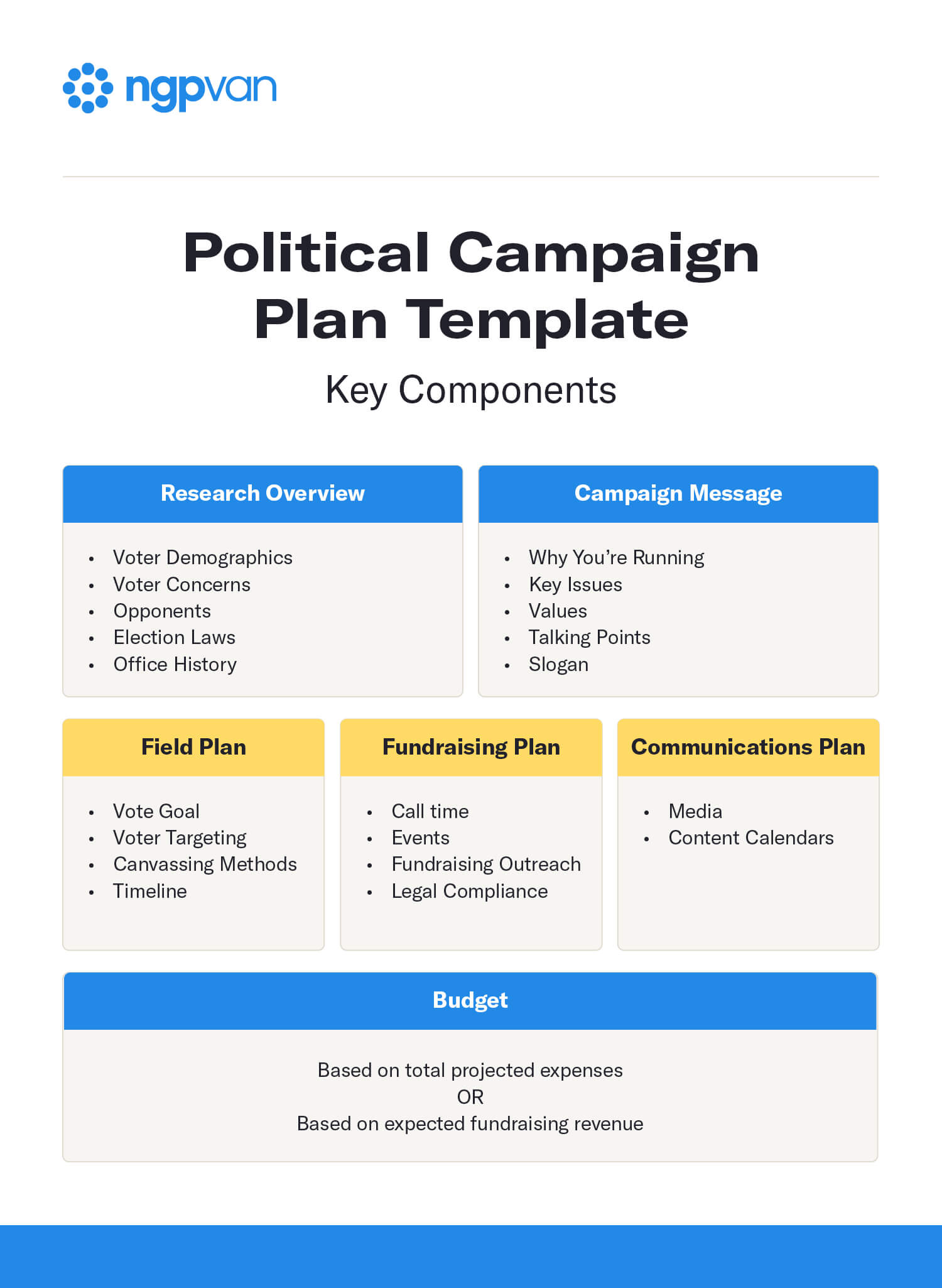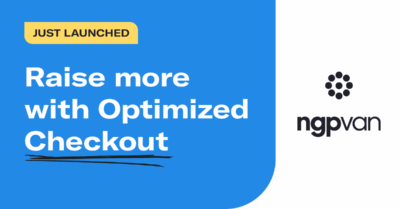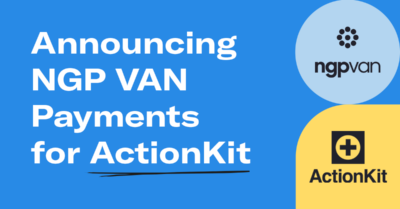How to write a winning political campaign plan

Launching a political campaign means embarking on a months- or years-long endeavor that requires collective effort, strategic management, and extensive planning. To navigate the complexities of the campaign trail, teams need a thorough plan to guide their efforts from the start of their campaign to Election Day and beyond.
When crafted well, a political campaign plan will lead your team through everything from day-to-day operations to major decisions about the campaign’s direction. That’s why we wanted to share how to write a comprehensive political campaign plan designed to lead your candidate to victory.
What is a political campaign plan?
A political campaign plan provides a structured roadmap for a campaign, outlining key objectives, strategies, and tactics to reach, mobilize, and persuade voters, supporters, and donors. It’s a living document that helps ensure resources are utilized efficiently and that the campaign stays focused on and progresses toward its goals.
The plan is typically drafted by the campaign manager (or sometimes the candidate themselves or a lead volunteer for smaller campaigns) with input and approval from the candidate and other trusted stakeholders.
Why do you need a written campaign plan?
A written, step-by-step political campaign plan is essential to keeping your team on track and running your campaign efficiently. Outlining every aspect of your plan to win your race ensures you fully understand the landscape, thoroughly evaluate your resources, and strategically approach all opportunities and challenges you may face on the campaign trail.
Plus, potential endorsers, donors, and other supporters will expect you to have a thorough campaign plan. Having this document at the ready helps you prove that your campaign is on the path to success and worthy of support.
Why use a political campaign plan template?
Since a thorough campaign plan is pivotal to a candidate’s success, you should use all the resources at your disposal to help you create one that’s streamlined and comprehensive. Using a political campaign plan template will help you:
- Structure your plan efficiently.
- Facilitate the research process.
- Brainstorm solutions to problems that may arise.
- Discover potential opportunities and challenges.
- Ensure you cover all your bases.
Ultimately, using a template like the one below to guide development will allow you to walk through your campaign step by step — pointing out any gaps in your strategy so you can address them and set your campaign up for success.

Use this template to jumpstart your thinking, then flesh out your campaign plan with more detail about your jurisdiction and the steps you’ll take to win your race.
Key components of a political campaign plan
As you sit down with your candidate and other campaign leaders to write or review your political campaign plan, ensure that it includes the following elements.
Research overview
Start your campaign plan with a summary of the research your team has done so far. This should include information about:
- Voter demographics: Who makes up the jurisdiction of the office you’re running for? Research the age range of voters, the partisan split, and other demographic factors that may impact your strategy. This information will help you direct your outreach strategy (like what methods you’ll use to contact voters and whether you’ll focus on mobilizing supporters or persuading more voters).
- Voter concerns: What were the key issues in the last election? What are voters’ top priorities, attitudes, and values today? Use polls, your knowledge of the district and its residents, and personal conversations with voters to find out what issues are on the top of voters’ minds. Understanding and centering these concerns in your campaign will help you run a more relevant campaign that speaks directly to voters’ concerns.
- Opponents: List each confirmed and potential opponent and what their stances are. Research their voting records, legislative records or advocacy, and public presence to get a sense of each opponent’s strengths and weaknesses. This opposition research will make it easier for you to compare where you both stand on the issues and give your campaign more information to use in negative campaigning if needed.
- Election laws: Ensure you know all the relevant election and finance laws for your election.
- History of the office you’re running for: Briefly describe the office’s recent history. For instance, has a Democrat held the office for the past two election cycles, but it’s been a close race? How successful have similar campaigns been in the past? What were their greatest challenges?
Add to this overview throughout your campaign as you learn more through further research. Keep your research section at the beginning of your political campaign plan to remind you of the core facts of race and what your candidate is up against.
Message
Based on your research, outline your campaign’s messaging, including how you’ll speak about your own campaign and your opponents. Your core message should succinctly answer the following questions:
- Why are you running for office?
- What are the key issues you plan to address?
- What values do you stand for?
- Why is your message important to voters, supporters, or donors?
- How will you address their concerns when elected?
Write out a one- to two-minute statement that addresses all of the above questions, then refine it to be more persuasive, direct, and easy for people to understand and resonate with. Create a list of talking points based on this message and a short slogan you can use in campaign materials. That short statement and additional talking points will come in handy when you start building out your canvassing and call time scripts to connect with voters and donors.
Additionally, include how you’ll respond to the ways opponents may talk about your campaign and the differentiators between your message and theirs. Having these responses drafted early on will make it easier to inform the rest of your team and volunteers about how you can respond to comments about your opponents in a consistent manner.
Field plan
Your field plan covers everything your team needs to do to reach out to, educate, and persuade or mobilize voters to vote for your campaign. This includes voter research, canvassing, phone banking, volunteer recruitment and coordination, and more. In this section of your political campaign plan, make sure to outline your:
Vote goal
Your campaign’s vote goal (or win number) is an estimate of the number of votes you need to win based on expected voter turnout. If you’re running in a two-person race, you can determine your win number by:
- Finding the number of voters expected to cast a ballot. Use your jurisdiction’s past election results to make an educated estimate of voter turnout, then multiply that percentage by the total number of registered voters. That will determine the total number of votes that are likely to be cast in this election.
- Calculating the number of votes you need to achieve a simple majority. Once you have the number of expected voters, multiply the number by 50% and add 1. Assuming you’re in a two person race, that’s your win number! In multi-candidate races, you may not need 50% to win your race because multiple candidates can pull smaller percentages, leading someone with less than 50% of the vote to win (unless you’re in a state with runoff elections that require candidates to win with at least 50% of the vote).
Knowing your vote goal is crucial for keeping your field plan on track and helping you determine which voters to target. You can then evaluate how many voters are likely to support your campaign and subtract that number from the expected voter turnout to figure out how many voters you need to convince or mobilize to support your campaign.
Voter targeting strategies
Campaigns often divide their target voters into two main universes (or groups of voters): persuasion and mobilization.
Your persuasion universe is made up of the voters you need to persuade to vote for you, such as members of other parties, those who don’t know about your campaign, and voters who are less likely to vote for you. These voters will likely need more touchpoints and one-to-one conversations to be convinced to support your campaign.
A mobilization universe includes likely supporters you need to convince to show up and vote. This often includes registered or likely Democrats and voters with a history of supporting similar campaigns. You’ll target these voters during Get Out the Vote (GOTV) efforts, where you’ll focus on encouraging supporters to get to the polls.
To create your two universes of target voters, use a voter database (like those provided by NGP VAN) to evaluate voters’ party affiliations (or lack thereof) and past voting habits. Then, create voter lists within your database to work with throughout the election cycle.
Outreach methods and timeline
Based on the preferences of your target demographic and the successes of past campaigns in your district, determine which outreach methods you will use to secure their support. These may include:
- Door-to-door canvassing
- Phone banking
- Text banking
- Campaign events
Then, estimate how many volunteers you’ll need and how often you’ll need volunteers to participate. Typically, it’s always best to recruit as many volunteers as possible to help you expand your outreach. However, realistically, you may want to set a baseline that you can use to evaluate your progress toward your volunteer recruitment goals.
Create a timeline for the duration of the election cycle that includes volunteer recruitment goals, training dates (if necessary), canvass launches, and other relevant dates like voter registration and early voting deadlines.
In this section, you should also note any tools you’ll use to help volunteers conduct their outreach, such as a canvassing app or phone banking tools.
Fundraising plan
This section of your political campaign plan outlines exactly how much you need to raise and the methods you’ll use to do so.
Start by setting a topline fundraising goal and choosing key performance indicators (KPIs) to measure your progress. These may include metrics like the number of calls made to donors, the total amount raised from an event, or the average cost per dollar raised. Then, determine who will oversee your fundraising strategies. This is often a finance or fundraising director, but campaigns without the budget to hire staff may have a team of volunteers take the lead instead.
Finally, outline the methods that your team will use to fundraise. These may include (but aren’t limited to):
Call time fundraising
Call time is a scheduled event in which a candidate calls potential donors and asks them to give to their campaign.
Plan out the details of the call time sessions you aim to host, including when your team will make the calls, what the call time process will look like, and what tools you’ll use to contact potential donors. To streamline the process, consider Call Time Mobile, our mobile call time app that allows you to call donors and make targeted fundraising asks from anywhere.
Events
Fundraising events can help you connect with donors face-to-face. Brainstorm ideas for small- or large-scale events based on the size of your campaign, and schedule potential dates to host them. Some events are more expensive and complex than others (such as a gala), so consider how much time and money you can afford to put into each potential event and if it would likely raise enough funds to justify that investment of resources.
Fundraising outreach
In addition to calling potential donors, most campaigns conduct outreach via digital and print channels, including email, text messages, online advertisements, and direct mail. Taking a multichannel approach to fundraising outreach helps you increase touchpoints with potential donors and boost your chances of securing their donations.
Analyze recent political fundraising trends to determine which channels will give you the best chances of success. You’ll also want to track all that outreach in a fundraising database to make sure you’re building comprehensive donor profiles, collecting data to inform future outreach, following up on outstanding pledges, and more.
Legal compliance
Your finance director (or other lead fundraiser), treasurer, or compliance consultant will be responsible for managing and reporting your campaign’s finances accurately, ensuring your campaign follows all relevant campaign finance laws in all fundraising activities.
Here, list all the campaign finance regulations for your election level and jurisdiction (if you’re unsure what they are, contact your relevant election authority to find out). Include contribution limits, compliance laws, and the reports you need to file and when they’re due. Plan out how you’ll record donations and expenses and file reports on time. This part of your plan should also document your choice of a compliance database that you want to use to compile and file your campaign finance reports.
Communications plan
Your communications plan outlines how your team will promote your campaign and create strategic touchpoints with different segments of voters. This part of your political campaign plan should cover how you’ll create an online presence for the candidate, what channels you’ll use to communicate with voters, and how to stay on top of your candidate’s public persona.
Ultimately, your communications plan is about strategically and consistently sharing your campaign message with the public. Within this section, include:
Media
Consider how you’ll leverage both paid and non-paid channels to promote your campaign throughout the election cycle. Depending on the resources at your disposal and the demographics of your target voters, your media strategy might include:
- Social media posts on Facebook, X (formerly Twitter), Tiktok, or other social media platforms
- Email outreach for voters, donors, and volunteers
- Targeted digital advertising, such as Google search ads or Facebook ads
- A campaign website that houses information about the candidate, a donation page, and email subscription and volunteer forms
- Text messages to supporters
- Press releases to local media outlets
- TV, print, and radio advertisements
- Mailers
Plot out each channel you’ll use and how you’ll present a cohesive brand and message across all of your communications. Additionally, include the names and information of contacts you have with local media outlets so you can easily reach out to them.
Content calendars
Content calendars will help your team meet publishing deadlines and keep your messaging consistent. Use them to map out:
- Key events: Include important campaign events, debates, fundraisers, and key election dates.
- Messaging: Plan out the messaging and themes for each piece of content to ensure consistency and alignment with the campaign’s goals and values.
- Platform: Specify which communication channels will be used and how frequently.
- Content types: Define the types of content you’ll create, such as videos, blog posts, infographics, and their formats, ensuring they cater to various preferences and engagement levels.
- File attachments: Include a section for attaching or linking to relevant files and assets, such as images, videos, graphics, or documents needed for each piece of content. This helps streamline the content creation process and ensures all necessary resources are readily available.
If you have a larger communications team, your content calendar is also a good place to share which team member is responsible for creating, editing, and publishing content.
Budget
Create a budget for your campaign that includes the projected costs of staff pay, ballot access, voter outreach, promotional materials, campaign tools, and any other campaign expenses. List any resources that you have already along with expected fundraising revenue. Then, determine how you’ll allocate funds to each area of your campaign.
Some campaigns decide to base their fundraising goal on projected expenses (i.e., “We need to raise $50,000 to cover all of the materials we plan to create”), while others base their budget off of expected fundraising revenue (“We can realistically raise $50,000. What materials can we afford with those funds?”).
Either way, you should pay close attention to your budget throughout the campaign and adjust it as needed based on your actual fundraising progress and expenses.
Supercharge your political campaign plan with NGP VAN
With its robust and industry-leading suite of voter outreach, fundraising, and data management tools, NGP VAN has everything you need to help you execute an effective political campaign plan. Streamline field operations, measure fundraising progress, and run a more effective campaign with our tools. Contact our team to find out how we can support your political campaign.






